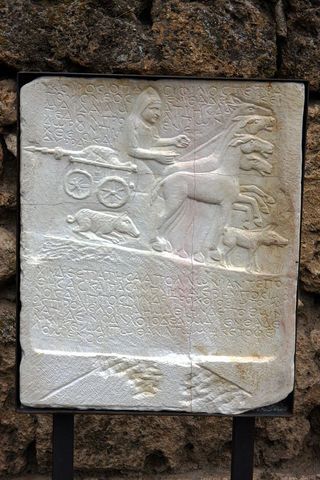
In the Roman Popular Culture course that I coordinate with Jerry Toner in Cambridge, we have been spending a bit of time thinking (a) about the role of pigs in popular culture (the famous Testamentum Porcelli being a great example, the spoof last will and testament of a pig called Marcus Grunter Corocotta, and well known to St Jerome as a text that made school kids hoot with laughter, and (b) about the role of the Roman epitaph and tomb design as part of non-elite self-representation in the Roman world (for example the so-called Tomb of the Baker or the bit in Petronius' Satyricon where Trimalchio gets down to his tomb design, chap. 70-71 here).
Anyway, we had a good 'show and tell' session in the last class of term, and one of the students brought along something that I confess I had not seen before, and about which I thought some of you might have some ideas?
It's the epitaph of a pig pictured above, apparently the victim of a traffic accident, from Macedonia, and of Roman date. (There is an article by G Daux about it in BCH (Bull. Corr. Hell.) for 1970, but I have been a bit confined to base, so haven't gone out to check it out... but from what I gather it doesnt answer by questions.)
Anyway the text in hexameters is:
χοῖρος ὁ πᾶσι φίλος,
τετράπους νέος,
ἐνθάδε κεῖμαι
Δαλματίης δάπεδον προλιπὼν
δῶρον προσενεχθείς
καὶ Δυρράχιν δὲ ἐπάτησα
Ἀπολλωνίαν τε ποθήσας
καὶ πᾶσαν γαίην διέβην
ποσὶ μοῦνος ἄλιπτος
νῦν δὲ τροχοῖο βίῃ
τὸ φάος προλέλοιπα
Ἠμαθίην δὲ ποθῶν
κατιδεῖν φαλλοῖο δὲ ἅρμα
ἐνθάδε νῦν κεῖμαι
τῷ θανάτῳ μηκέτ’ ὀφειλόμενος
And the English translation, courtesy of Wiki, is:
A pig, friend to everybody
a young four-footed one
here I lay, having left
behind, the land of Dalmatia
,as an offered gift,
at Dyrrachion I walked
Apollonia yearning
and all the road I crossed
on foot alone steadily.
But by the force of a wheel
I have now lost the light
longing to see Emathia
and the Phallic Chariot
Here now I lie, owing
nothing to death anymore
Ok, so my question is, what kind of thing is this. If it is a spoof, like Testamentum Porcelli and of that genre, then it is a very expensive one, all reasonably inscribed with a not-bottom-of-the-range bit of relief sculpture. But does it make any sense to be "real"? There are several examples in the ancient anthologies of funerary epigrams for animals, including the one on Hadrian's horse Borysthenes:
Borysthenes Alanus,
the swift horse of Caesar,
who was accustomed to fly
through the sea and the marshes
and the Etruscan mounds,
while pursuing Pannonian boars, not one boar
dared him to harm
with his white tooth:
the saliva from his mouth
scattered even the meanest tail,
as it is custom to happen.
But killed on a day in his youth,
his healthy, invulnerable body
has been buried here in the field.
But it's not quite the same somehow.
So maybe it is about a man called Choiros (= "pig"), and the relief is a visual pun on his name? That would put it in the same category as the tombstone of the priest of Cybele from Ostia which is decorated with a large cockerel (gallus = in Latin both "priest of Cybele" and "cockerel", the source of many puns in Latin).
Any thoughts?
 newest »
newest »
 newest »
newest »
 That is far too elaborate in my view for it to be a hoax. The money it must have cost to execute the piece, not to mention the time- all for a laugh. I just don't think it so. Pigs can be intelligent, lively creatures and perhaps this was a fond pet? The epitaph evokes well the brevity of life and tinges it with a quiet melancholy, akin to a meditation of sorts. I'll certainly remember this little fellow. And maybe that was the point. Cheers.
That is far too elaborate in my view for it to be a hoax. The money it must have cost to execute the piece, not to mention the time- all for a laugh. I just don't think it so. Pigs can be intelligent, lively creatures and perhaps this was a fond pet? The epitaph evokes well the brevity of life and tinges it with a quiet melancholy, akin to a meditation of sorts. I'll certainly remember this little fellow. And maybe that was the point. Cheers.




